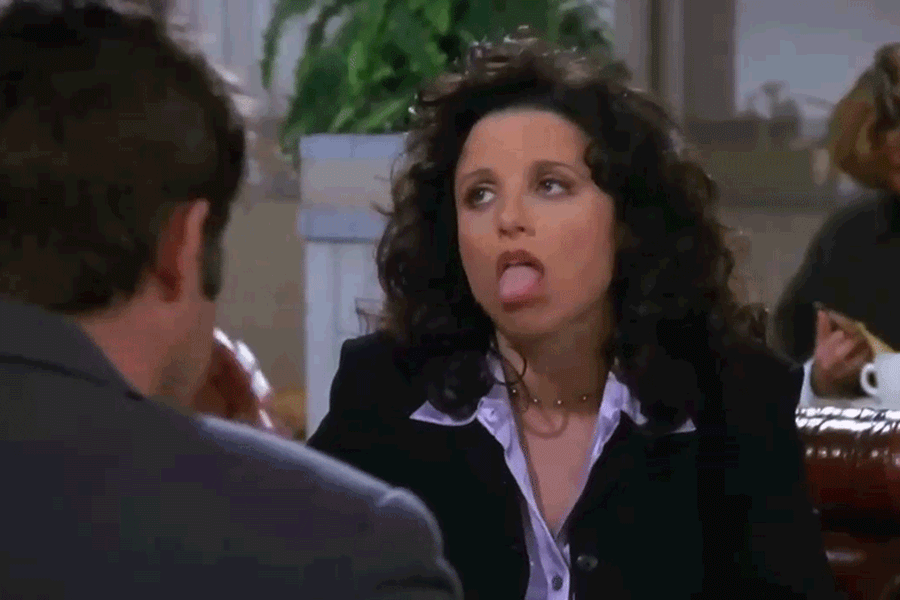However relatable they may be, sitcoms don’t generally succeed on the strength of their realism. Even Seinfeld, steeped in quotidian concerns over phone etiquette and restaurant politics, leaned into exaggerations to make its “nothing” premise work. And since the series threw focus at the leads’ professional and romantic lives, many of the caricatures it produced were either recurring bosses or one-off love interests.

Jerry, George and Kramer churned through a roster of semi-girlfriends well out of their league and typically defined by the single trait that precipitated a breakup — the annoying laugh, some hygienic faux pas, etc. None of the guys seemed to care who they were dating, so long as they had a date, and they let go of each soured relationship as if expecting a fresh one soon. Jerry memorably remarks that he’s been going out with a woman “since the last one,” and even George’s eventual engagement feels accidental, unrelated to his behavior or (decidedly lacking) amorous ambitions.

Elaine Benes was different. The same combination of snappy writing and iconic performance that made her Seinfeld’s “most complex, quirky and ultimately hilarious character” also elevated the erotic adventures she embarked upon. As petty and picky as her male friends, Elaine was nonetheless questing for meaningful heterosexual partnership. She sought out intellectual and professional men, doctors above all, who met her criteria for a stable significant other — but she wasn’t in a rush to marriage, nor immune to affairs with hot dudes whom she knew to be dumb, pretentious or otherwise unpromising. This was her delicate balancing act: to achieve sexual gratification while stealthily laying the groundwork for a commitment, all without spooking the guy.
It’s no accident that Elaine’s most infamous storyline saw her ruthlessly appraising whether the current suitor was “spongeworthy,” which is to say deserving of intercourse using her favorite — but discontinued and perilously scarce — contraception. It’s not just that she teased the possibility of sex in exchange for the boyfriend cleaning his bathroom and trimming his sideburns, and neither is it merely analysis as to the trade-off between instant mediocre coitus and potential future orgasmic bliss. Rather she blends these lines of thought into a single Machiavellian approach to determine both fuckability and continuing return on investment. It’s thrilling to watch her in action.
And partners’ grooming habits weren’t the only thing Elaine aimed to influence. Whereas her male cohort considered themselves lucky to keep any attractive woman close, regardless of her flaws, Elaine was hardly content with compromise. Over the course of the show, she tried to turn a gay man straight, urged someone with the same name as a serial killer to legally change it (but not to any of the names he happily suggested) and convinced a cunnilingus-avoidant jazz musician to give it a go, even offering gentle support when he turned out to be terrible at it. Meanwhile, she’s not afraid to speak her truth on The English Patient (“How about, it sucked?”), defying the boyfriend and eccentric employer in a situation where George or Jerry would have lied through their teeth to maintain the status quo.
Despite the mountain of evidence to the contrary, Elaine believes she can — and should! — have it all, and that she has the power to shape raw life into its shining ideal. By virtue of that same utopian instinct, she nearly lands a couple of celebrities, including Keith Hernandez and John F. Kennedy Jr.
Of course, for a comedy to endure, no such resolution may be achieved. Which brings us to Elaine’s most memorable boyfriend: David Puddy. Her on-again, off-again relationship with this deadpan mechanic-turned-car-salesman is scattered through 11 episodes, making him a presence second only to George’s fiancée Susan among side characters sleeping with the regular cast. Together, Puddy and Elaine are that couple who can fight over pretty much anything, and often do split up, but are always drawn back together by the gravitational force of laziness.
Elaine is fully aware that she can do better than Puddy, who as a somewhat lunkheaded religious jock with a fondness for Arby’s and atrocious outerwear is nowhere near her type, yet he serves as a comfortable baseline — a reliable, low-key provider of apparently decent dick. She’s wise enough to see that there are times when your best bet is the safe one: a burly doofus who gives too many high-fives. Outside the bedroom, they demonstrate a dumbed-down version of the Elaine-Jerry dynamic, content in a sort of cozy boredom.
Jerry is himself an ex of Elaine’s, and perhaps the greatest proof of her enlightened approach to male/female companionship. As frequently as Jerry disparages her taste in men, she never points out that he’s insulting himself, and usually teases him in kind about the women he chases. When the revelation of her faked climaxes threatens to tear them apart, she pitches “sex to save the friendship,” giving the fragile comedian a shot at closure while casually diminishing the fraught importance he ascribes to the act.
It takes two to achieve the canonically impossible feat of becoming and remaining a platonic pair after intimate involvement, yet we get the sense Elaine does the brunt of the emotional labor to keep the rapport running smoothly — and so, they both may confide in the other regarding their latest romantic prospect.
In short, without her, Seinfeld would be a show about guys trying to get laid; with her, it’s a treatise on human desire.

But don’t take my word for it. Fire up Hulu and watch Elaine fall for guys because they have a pleasing voice or great movie recommendations while rejecting the louts who oppose abortion or expose themselves on the first date. When the closing credits roll, she’ll likely be alone again — but rarely because she wasn’t right. The really unbelievable aspect of Seinfeld is that Elaine wasn’t happily settled down with a handsome millionaire from the pilot onward.
It just wouldn’t have been as funny, I guess.

